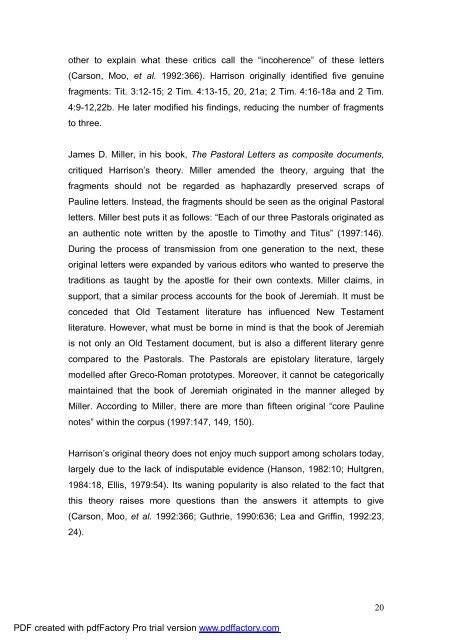A Text centred rhetorical analysis of Paul's Letter to Titus
A Text centred rhetorical analysis of Paul's Letter to Titus
A Text centred rhetorical analysis of Paul's Letter to Titus
You also want an ePaper? Increase the reach of your titles
YUMPU automatically turns print PDFs into web optimized ePapers that Google loves.
other <strong>to</strong> explain what these critics call the “incoherence” <strong>of</strong> these letters<br />
(Carson, Moo, et al. 1992:366). Harrison originally identified five genuine<br />
fragments: Tit. 3:12-15; 2 Tim. 4:13-15, 20, 21a; 2 Tim. 4:16-18a and 2 Tim.<br />
4:9-12,22b. He later modified his findings, reducing the number <strong>of</strong> fragments<br />
<strong>to</strong> three.<br />
James D. Miller, in his book, The Pas<strong>to</strong>ral <strong>Letter</strong>s as composite documents,<br />
critiqued Harrison’s theory. Miller amended the theory, arguing that the<br />
fragments should not be regarded as haphazardly preserved scraps <strong>of</strong><br />
Pauline letters. Instead, the fragments should be seen as the original Pas<strong>to</strong>ral<br />
letters. Miller best puts it as follows: “Each <strong>of</strong> our three Pas<strong>to</strong>rals originated as<br />
an authentic note written by the apostle <strong>to</strong> Timothy and <strong>Titus</strong>” (1997:146).<br />
During the process <strong>of</strong> transmission from one generation <strong>to</strong> the next, these<br />
original letters were expanded by various edi<strong>to</strong>rs who wanted <strong>to</strong> preserve the<br />
traditions as taught by the apostle for their own contexts. Miller claims, in<br />
support, that a similar process accounts for the book <strong>of</strong> Jeremiah. It must be<br />
conceded that Old Testament literature has influenced New Testament<br />
literature. However, what must be borne in mind is that the book <strong>of</strong> Jeremiah<br />
is not only an Old Testament document, but is also a different literary genre<br />
compared <strong>to</strong> the Pas<strong>to</strong>rals. The Pas<strong>to</strong>rals are epis<strong>to</strong>lary literature, largely<br />
modelled after Greco-Roman pro<strong>to</strong>types. Moreover, it cannot be categorically<br />
maintained that the book <strong>of</strong> Jeremiah originated in the manner alleged by<br />
Miller. According <strong>to</strong> Miller, there are more than fifteen original “core Pauline<br />
notes” within the corpus (1997:147, 149, 150).<br />
Harrison’s original theory does not enjoy much support among scholars <strong>to</strong>day,<br />
largely due <strong>to</strong> the lack <strong>of</strong> indisputable evidence (Hanson, 1982:10; Hultgren,<br />
1984:18, Ellis, 1979:54). Its waning popularity is also related <strong>to</strong> the fact that<br />
this theory raises more questions than the answers it attempts <strong>to</strong> give<br />
(Carson, Moo, et al. 1992:366; Guthrie, 1990:636; Lea and Griffin, 1992:23,<br />
24).<br />
PDF created with pdfFac<strong>to</strong>ry Pro trial version www.pdffac<strong>to</strong>ry.com<br />
20

















